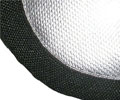3D
| Description | |
|---|---|
 |
the 3D Welding Technique Waterproof ORTLIEB products are not sewn or glued, but the parts required for a bag are firmly joined by means of high frequency welding. This creates a waterproof and extremely durable connection. |
| Differences The 2-D-welding process is used for flat products like mapcases and document bags, consisting of an upper and a lower side, these are then welded together along the edges. The 3-D-welding process is used for producing three-dimensional products like bike panniers, panniers and drybags. |
|
ORTLIEB bike panniers consist of 3 sections of material that are welded together: the front (1) and rear section (2) are connected / welded to each other by means of a “circumference piece” (3) with an approx. 10mm wide overlapping seam. This is how a three-dimensional product with height, width and depth is created (e.g. Back-Roller Classic). |
|
| ORTLIEB drybags consist of one piece cut out of fabric. This piece is welded along a seam into a tube; later the bottom is welded into the bag; this is how a three-dimensional product is created in the case of a drybag. |






